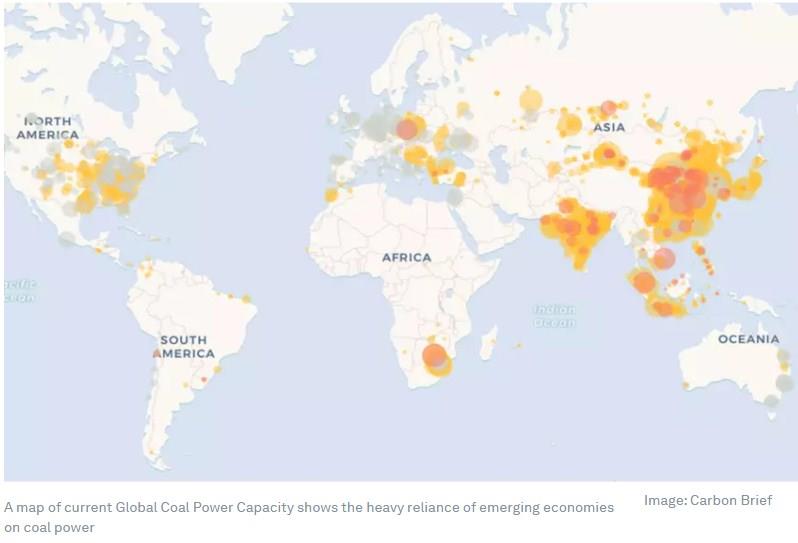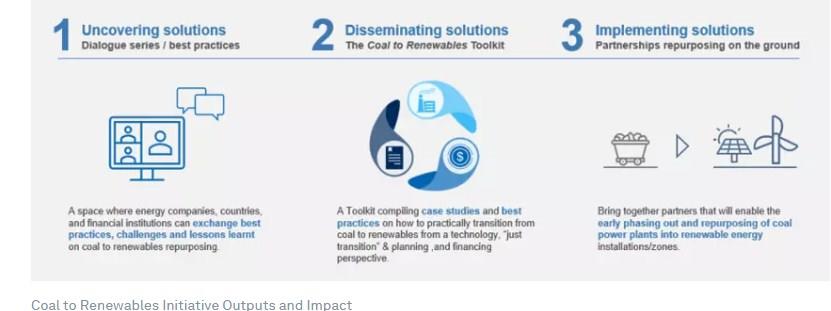by Melissa Stark, Fabio Cataudella and Jorge Mayer*
At the B20 launch earlier this year, President Joko Widodo of Indonesia emphasized his country’s potential for 418GW of renewable energy production. In a country where up to 60% of the energy mix is from coal, he added that his government is getting ready to retire up to 5,5GW of coal generation capacity, while cautiously exploring how this transition could adversely affect Indonesian people’s lives.
Lessons from companies like Enel and EDP, who have transformed assets from coal to renewables while taking care of the local communities, can help in this conversation and are critical for the COP26 phasing-down of coal pledge.
The role of coal in the energy transition
Today, coal represents 44% of global CO2 emissions and 40% of global installed generation capacity. Of this, 75% is installed in Emerging Markets and Developing Economies (EMDEs), which relies on coal energy for economic development and energy assurance to communities.
As energy needs rise in EMDEs, plans are in place for a further 500GW of coal capacity to be built in the next 10 to 15 years. At the same time, if the world wishes to stay on track to reach net-zero by 2050, the IEA estimates that all unabated coal must be phased out by 2040.
The good news is that renewable energy is increasingly cost-competitive. Today, 77% of new renewables’ Levelized Cost of Energy (LCOE) is lower than existing coal. By 2030, that share will be 99%.

The different social benefits of repurposing
The transition from coal to renewables isn’t just about the LCOE of these technologies, but also about effects on all stakeholders involved. This includes the impact on people who are directly employed by coal power plants, people indirectly dependant thereon for employment, and communities built around these.
Repurposing coal power plants to renewable ones is a key consideration for the just transition. Alongside its social benefits, coal power plant repurposing also presents other advantages and benefits. These include land space, interconnection lines, generators, synchronous condensers, and substations.
Enel and EDP, for their part, have spent the past decade transitioning from thermal to renewable power. This drive includes committing to the decommissioning of coal power plants.
Enel has committed to exiting coal completely by 2027, and the remainder of thermal power by 2040. It has also committed to find new life for such plants, aiming to maximise their use as energy providers through repurposing into solar, wind, or green hydrogen sources, storage options, or synchronous compensators.
Enel’s approach to repurposing focuses on cooperation with local stakeholders throughout the process and total retention of all non-retiring employees. Circularity is also a chief concern. Enel aims to reuse as many key components of the coal power plant as possible without creating unnecessary waste. Enel’s commitment also goes beyond its employees. It’s helping suppliers transform their businesses, and retrain their employees to adapt to a transformed operations model.

Energy companies leading by example
In Spain, Enel is repurposing the Teruel coal power plant by replacing an installed capacity of 1,100MW with a large hybrid renewable plant of 1,500MW, including solar, wind and battery storage. In Chile it is repurposing the Tarapaca coal power plant into a hybrid project which will have a photovoltaic plant, an energy storage system, and room for salt storage by a third company.
EDP, meanwhile, is accelerating its energy transition by committing to being coal-free by 2025. It aims to be carbon neutral by 2030 - with 100% renewable energy generation.
EDP is preparing the closure of its coal power plants. Its energy transition projects in Portugal, Spain, and Brazil are well underway. In January 2021, EDP closed Sines, Portugal’s largest coal power plant and will turn this decommissioned site into a green hydrogen hub.
EDP’s repurposing plans follow a multi-stakeholder approach. Here, government, academia, NGOs, EDP and its suppliers, all work together to ensure the creation of new economic activity in communities. EDP’s hydrogen related activities include a green ammonia pilot project, a 100MW green hydrogen production facility, and a collaborative lab to promote hydrogen knowledge exchange.
EDP aims to ensure that no direct employees would lose their jobs. Similarly, they wish to see suppliers’ employees have access to renewable energy jobs. To that end, EDP provides re-skilling, psychological and social support to all suppliers’ employees impacted by Sines’ closure.
The Coal to Renewables Initiative
Enel and EDP recently presented their stories at the inaugural meeting of the Coal to Renewables initiative, launched by the World Economic Forum. This collaboration with Accenture is a unique space where 50+ stakeholders from energy, finance and civil society exchange best practices and seek partnerships to accelerate coal repurposing projects.
The Initiative allows participants, like Enel and EDP, to share real case studies and the challenges and opportunities faced in the coal to renewables transition. It also has a practical toolkit showcasing technology, finance, just transition and planning case studies. The goal is to create shared understanding and effective partnerships for the just transition.
*Head, Global Renewables and Energy Transition, Accenture and Head of Power Plants Repurposing, Enel and Head of Stakeholder Management, EDP - Energias de Portugal
**first published in: www.weforum.org




 By: N. Peter Kramer
By: N. Peter Kramer

